A step-by-step guide to unanticipated change management

How to strategically lead your organization through COVID-19 crisis (with worksheets)
Change management is a methodology and process for managing the people side of a change.
Oftentimes, changes are strategically planned by organizations allowing for adequate time to design and implement both project and change management. Other times, organizations are forced to change unexpectedly, without notice or proper preparation.
This guide is designed for organizations that are experiencing the latter – to help build an effective change management strategy that focuses on the most critical aspects of an unanticipated change. It is designed to take an agile approach to the PROSCI© methodology for assisting organizations in anticipating, recognizing and addressing individual reactions to a change.
Guide overview
This guide includes six distinct steps.
Each step includes a number of recommendations, best practices and considerations, along with resources for documentation and execution.






Step 1: Assemble a team
Research shows that the number one contributor to successful change is active and visible leadership. That said, the first step in responding to an unanticipated change is to create a team that will be responsible for the planning, execution and monitoring of the change. This team will also work to set the tone for the rest of the organization through their leadership.
The team should include people who are well-respected, informed and committed to driving the change at their level.
Team members should have:
- The ability and willingness to contribute time and resources
- An understanding of the change and the organizational knowledge
- Strong leadership, communication and interpersonal skills
A primary role on the Change Team is the Executive Sponsor. The Executive Sponsor is the person or persons (up to 2) ultimately responsible for owning the change and is accountable for its success. The Executive Sponsor also provides overall guidance and leadership to the change team along with resources to ensure achievement of goals.
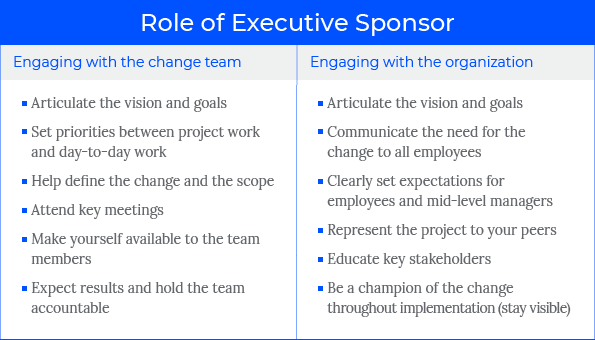
All other team members are called Sponsors and are responsible for offering input and assistance in implementation. Sponsors also serve as an internal resource to leaders and managers within the organization relative to the change.
It’s important that Sponsors are prepared to handle the heightened anxiety that many feel during unanticipated change. Being sincere is one key way sponsors can ease anxiety.
Resource and instructions
Use the Change contact sheet to identify and document the names and email addresses for each of the Change Team members. Use the last row to identify 2-3 preferred communication methods for the Change Team. Communication vehicles can include scheduled meetings, memos, repositories, etc.
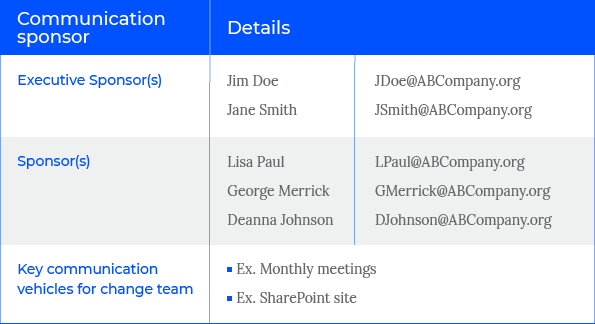
Step 2: Assess the situation
In order to effectively develop change management plans, an assessment of the scope and scale of the change is needed. Thoughtfully assessing and defining the change will help create a shared vision or “north star” for the Change Team and the organization for guiding them into the new direction.
When assessing the situation, consider the following questions:
- Why is it happening? What is the urgency? Why?
- What effect can we anticipate this change having on the organization?
- How broadly will this change reach across our organization?
- How equipped/prepared is the organization to manage this change?
- What resources are needed to support the change?
As you review these questions, develop plans for the change or implement the change, you may find that additional efforts may be needed now or in the near future to support the initial incident.
The examples provided in the Change Initiative Recorder resource illustrate two distinct change initiatives related to the unanticipated coronavirus (COVID-19) outbreak. While these changes are related, they are distinct in objective, urgency and impact.
Resource and instructions
Use the Change Initiative Recorder to record the details of the change or changes your organization is experiencing. Use the document as a single-source of truth, referring back to it when developing or disseminating any communications out to sponsors, agents or stakeholders to ensure messages alignment and accuracy.
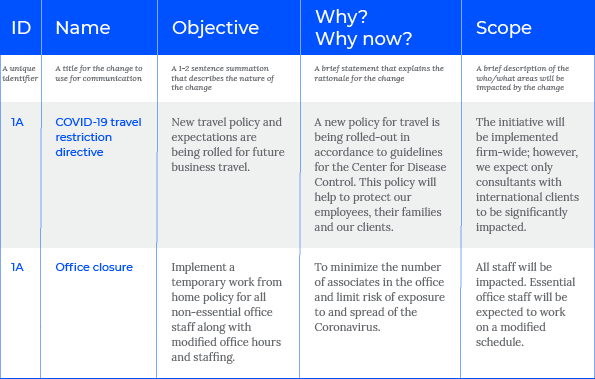
Step 3: Activate agents
Inspire confidence in leaders at every level by activating a coalition of Change Agents who have the skills and willingness to help push the change effort forward. Change Agents are primarily responsible of disseminating messages and clarifying expectations for success to employee’s before, during and after the change. As such, there are five different roles Change Agents play: communicator, advocate, coach, liaison and resistance manager.
Generally, people managers make the best Change Agents as they are close to the action, likely have demonstrated leadership skills needed to generate commitment and are, by nature of their role, responsible for helping employee navigate through change. However, there may also be individual contributors that may possess the necessary energy and commitment for the change to make successful agents.
The Change Team should take inventory of the talent and anticipated commitment available to support the change. With the right resources and information Change Agents can effectively bolster employee’s confidence throughout the change.
The Change Team should involve Agents early and provide talking points for discussing the change with their employees and opportunities, both formal and informal, to engage with the Change Team for guidance.
Resource and instructions
Have each sponsor review and familiarize themselves with the roles document, which includes detailed responsibilities and tactics.
Then sponsors should go over those roles, responsibilities and tactics with the Change Agents to set expectations.

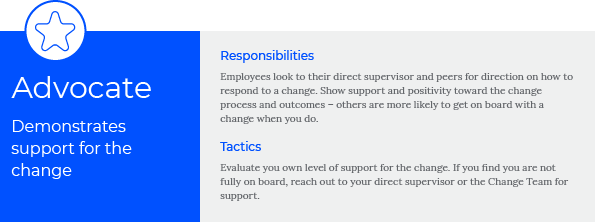


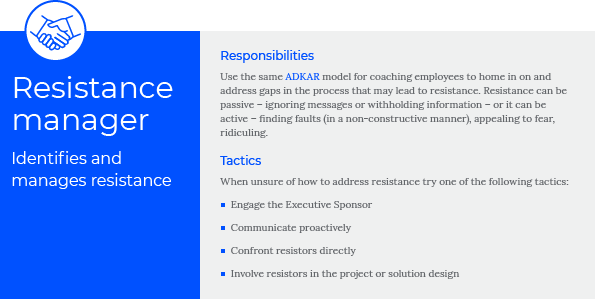
Adapted from PROSCI© “Manager/Supervisor’s Role in Change Management”
Step 4: Develop a plan
Once the change is defined and mechanisms are in place, a story of change must be communicated to the organization.
Effective communication helps build understanding and generate buy-in from employees, giving them the information and energy needed to act. But communication alone won’t address individual emotions, which can impede transitions.
To help address those emotions, Change Team needs to help support employees as they prepare for, transition through and sustain the change. The Awareness, Desire, Knowledge, Ability and Reinforcement (ADKAR) model helps us understand the levers that need to be addressed as a change is rolled out.
Failing to address these elements can lead employees to actively or passively resist the change — delaying adoption, creating more uncertainty and diminishing trust between the employees and the organization.
The ADKAR chart can be used as the Change Team brainstorms communication and support activities for employees, people managers and Change Agents. For additional information on objectives, tactics and sample activities for each of the ADKAR elements, download our detailed grid.

Resource and instructions
Have the Change Team meet to complete the Communication and Support Plan. The meeting should be scheduled for 2-4 hours, depending on the scope and impact of the change. Additional members of the organization may need to be pulled into this meeting to ensure there is a representative from each critically impacted stakeholder group that can speak to the needs and concerns for the respective group. Note that the Communication and Support Plan is fluid and will require regular review, modifications and additions by the Change Team. Make sure to establish a defined cadence for reviewing and tracking progress against the plan.

Step 5: Implement plans
Make change happen by proactively executing on and monitoring progress against the plan. The most effective way to create engagement and sustain momentum throughout the change is to have change leadership that is actively and visibly involved in the change.
Have Sponsors evaluate their contribution and awareness throughout implementation to ensure they are actively engaged and committed to the project. Look to the Executive Sponsor, Sponsors, and/or their direct supervisor for guidance and support if and when needed.
Resource and instructions
After the change has taken place, use the Sponsor Checklist to assess the effectiveness of Change Sponsors. Complete the activity at least bi-weekly or as often as needed.

Step 6: Evaluate and adjust
Even the best planned and executed changes need to be regularly evaluated for success and course correction. Ensure the change stays on track for success by setting cadence for review and adjustments.
When evaluating the plan, use observations and feedback to look for indicators of resistance such as:
- Confusion about the change
- Silence, indifference, or disengagement from impacted employees and people managers
- A sense of fear or anxiety surrounding the change
- Frustration or conflict that arises during the change
- Lack of participation in the change or employees reverting to the “old way”
Depending on the type of resistance determine what additional communication or support activities are needed to combat the resistance.
You may also find that the organization may need to implement additional changes to support the original change. When this happens, continue activities for the original change and begin planning the supplementary change with Step 2: Assess the situation. Add to the current documentation to keep a full view of the related changes that are affecting your organization. Leverage existing change resources and plans to support the additional change initiatives.
Resource and instructions
Use this matrix to determine which evaluation methods to implore for the change and when. Include these activities as part of the Communication and Support Plan.
Download resources
Here are the links to all the resources outlined in the article:
If you have any questions or need help with change management, reach out to our Talent and Change team.





